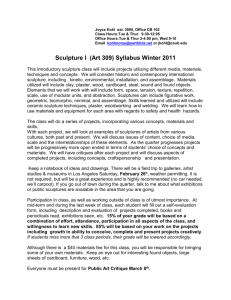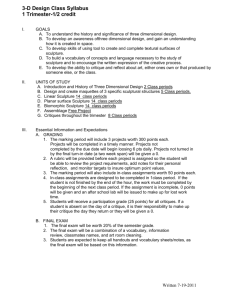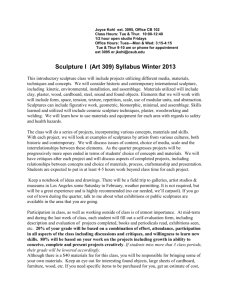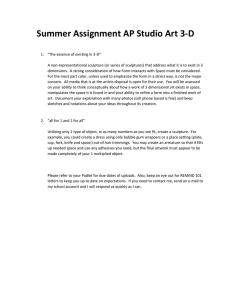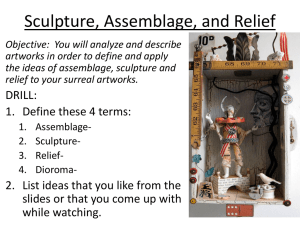Sculpture Studio
advertisement
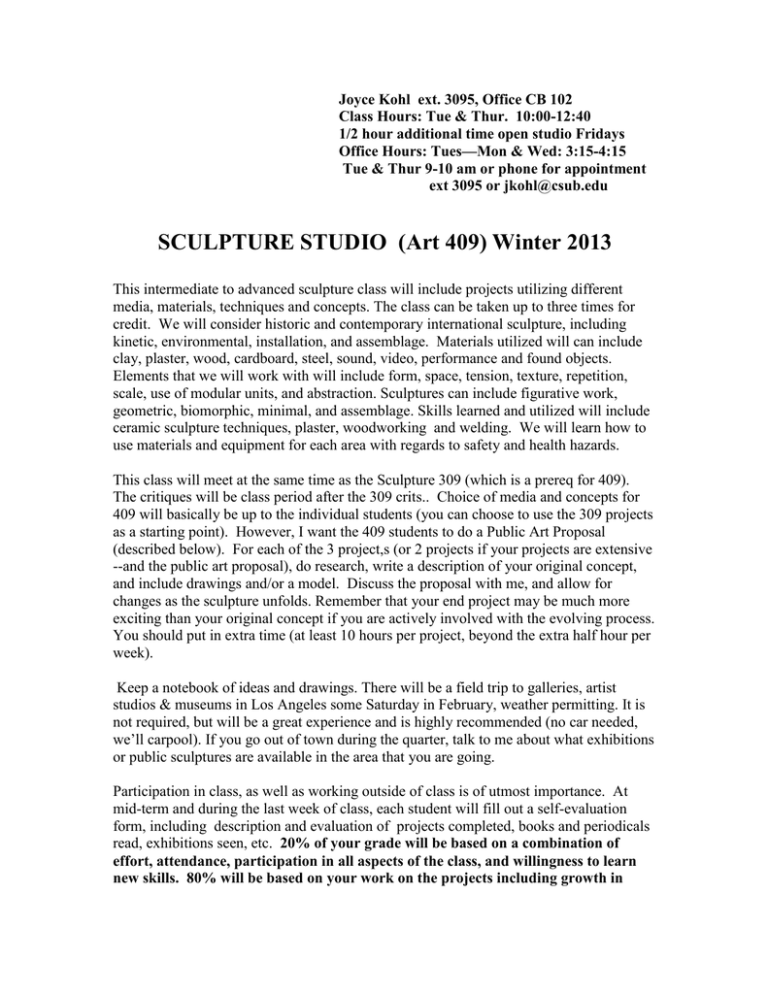
Joyce Kohl ext. 3095, Office CB 102 Class Hours: Tue & Thur. 10:00-12:40 1/2 hour additional time open studio Fridays Office Hours: Tues—Mon & Wed: 3:15-4:15 Tue & Thur 9-10 am or phone for appointment ext 3095 or jkohl@csub.edu SCULPTURE STUDIO (Art 409) Winter 2013 This intermediate to advanced sculpture class will include projects utilizing different media, materials, techniques and concepts. The class can be taken up to three times for credit. We will consider historic and contemporary international sculpture, including kinetic, environmental, installation, and assemblage. Materials utilized will can include clay, plaster, wood, cardboard, steel, sound, video, performance and found objects. Elements that we will work with will include form, space, tension, texture, repetition, scale, use of modular units, and abstraction. Sculptures can include figurative work, geometric, biomorphic, minimal, and assemblage. Skills learned and utilized will include ceramic sculpture techniques, plaster, woodworking and welding. We will learn how to use materials and equipment for each area with regards to safety and health hazards. This class will meet at the same time as the Sculpture 309 (which is a prereq for 409). The critiques will be class period after the 309 crits.. Choice of media and concepts for 409 will basically be up to the individual students (you can choose to use the 309 projects as a starting point). However, I want the 409 students to do a Public Art Proposal (described below). For each of the 3 project,s (or 2 projects if your projects are extensive --and the public art proposal), do research, write a description of your original concept, and include drawings and/or a model. Discuss the proposal with me, and allow for changes as the sculpture unfolds. Remember that your end project may be much more exciting than your original concept if you are actively involved with the evolving process. You should put in extra time (at least 10 hours per project, beyond the extra half hour per week). Keep a notebook of ideas and drawings. There will be a field trip to galleries, artist studios & museums in Los Angeles some Saturday in February, weather permitting. It is not required, but will be a great experience and is highly recommended (no car needed, we’ll carpool). If you go out of town during the quarter, talk to me about what exhibitions or public sculptures are available in the area that you are going. Participation in class, as well as working outside of class is of utmost importance. At mid-term and during the last week of class, each student will fill out a self-evaluation form, including description and evaluation of projects completed, books and periodicals read, exhibitions seen, etc. 20% of your grade will be based on a combination of effort, attendance, participation in all aspects of the class, and willingness to learn new skills. 80% will be based on your work on the projects including growth in ability to conceive, complete and present projects creatively. If students miss more that 3 class periods, their grade will be lowered accordingly. Although there is a $40 materials fee for this class, you will be responsible for bringing some of your own materials. Keep an eye out for interesting found objects, large sheets of cardboard, furniture, wood, etc .We will supply clay, plaster, glazes, other casting materials and some metal and wood. Let me know if you need other materials including a particular type of metal or wood.. Everyone must be present for Public Art Critique March 12th. Final Critique is March 14th, (mandatory attendance--regular class time). We will look at our final project, and at documentation that you have done on previous projects. Projects: At the completion of each project, photograph east sculpture from several different viewpoints to document. You can check out a camera from Jesse Sugermann. We will view these photos during the final critique and you need to turn a disc with your images and a written description of the sculpture on March 14th. In 409 you can either start with the projects that the 309 class is working on, or define your own perimeters. For the first project, consider the following : . Do a sculpture or installation, which plays between manmade and natural. Do a sculpture or an installation, which utilizes some aspect of the figure and some aspect of the environment. You can repeat one element, such many fingers or faces—the figure or element of the figure can be abstracted. You can incorporate the figure into the environment, or visa versa Work can be autobiographical and/or can make a statement about the environment or some aspect of people in relationship to their environment. Consider a subject that is of concern to you. We will look at slides of sculpture relating to this project including work of American sculptors George Segal, Edward Kienholz, Viola Frey, John Outterbridge, John Riddle, Italo Scanga, Polish sculptor Magdalena Abakanowicz, Contemporary Chinese sculptors and ancient Chinese warrior figures, Japanese Haniwa figures, and African terra-cotta heads. Critique Feb. 5th (20% of grade) Second Project—Is totally up to you. The 309 class will be doing an assemblage project, incorporating various found objects (can be metal, fabric, furniture, etc.) to create something new, which may also have layers of the original objects. Incorporate some element of 2-dimensional techniques (painted, drawn, or photographed) with 3dimensional elements.. We will see slides of American sculptors including George Herms, Italo Scanga, Edward Kienholz, Louise Nevelson, Betty Saar, Gordon Wagner, Noah Purifoy, and international artists including Joseph Beuys, and contemporary African and Japanese sculptors utilizing assemblage. Critique Feb. 26st (20% of grade) Definitely do this project: Public Art Proposal: Do a proposal with written description and visual elements (drawings, model and photos) for a temporary or permanent public art sculpture or installation. Choose an appropriate site (doesn’t have to be local) for your concept or visa versa. Use a digital camera to photograph the model & the site, and combine them using Photoshop to clearly show the scale in relationship to the site. Consider safety, interaction with public, scale in relationship to site. Clearly describe your choice of site, materials, etc.and how viewers will interact with it. Proposal should be comprehensible without the necessity of you being present to explain it. (As though a review committee was evaluating it). Display can be by display board or power point—if power point, you need to provide the computer, and hook it up so that the reviewers can see it individually. Slides will include artists utilizing Public Art and Earthwork artists (Richard Sera, Mary Miss, Robert Smithson), Christo, Claes Oldenberg, Martin Puryear, Isamu Noguchi, and various sculptors that have worked on our campus We will put proposals on display for the class to evaluate on March 15th (20% if grade). The Final Project is totally up to you. The 309 class will be doing a project utilizing illusion or actual movement (kinetic), with substantial scale (depending on material) March 14th (20% of grade). We will also look at anything else that we haven’t seen completed. Turn in your disc of documented work and written descriptions. In all critiques, work will be evaluated on: the degree of ambition involved in undertaking the project, the thoroughness and thoughtfulness of the execution, the depth of the concept, improved skills and willingness to take risks. Growth in each of these areas is expected from one critique to the next. Students must be prepared to discuss their own work and the work of classmates in depth in a challenging, creative, thoughtful, and respectful manner. A = Outstanding. Expansive investigation of concepts and. skillful execution of a body of work.. Insightful contributions to critiques. Goes substantially beyond minimum requirements. Student works well beyond in class time. B = Above average. Substantial investigation of concepts and excellent craftsmanship. All assignments completed on time, insightful contributions to critiques. Excellent attendance and student works at least 2 hours beyond class time. C = Average. All assignments done competently.. Strong participation in critiques. Good attendance. Little or no work in studio beyond class time. D= Marginal work. Excessive absences, limited work, poor craftsmanship, or. Limited contribution to critiques. F = Unsatisfactory work.Course Extreme number of absences and tardies, Insufficient quanity and quality of work. Upon completion of this class you will: 1. Know how to safely use a wide variety of tools, materials and techniques. 2. Know how to use, digital technology, research, mathematics and drawing to aid in the development and execution of your ideas. 3 Learn how to safely install, mount, suspend, and/or anchor and light your finished work in a gallery. 4. Have experience presenting and talking about your work and know how to respectfully discuss the work of your classmates. 5. Know how to differentiate and discuss different types of sculptures, eg. minimal, abstract, figurative, assemblage, bricolage, representational, installation, site-specific, earthworks, etc. 7. Become familiar with and be able to talk about significant historic and contemporary sculptors. 8. Learn how to photograph your work for your portfolio. Art Program Objectives: Applies to all Art Majors: Objective 1: Graduates will demonstrate the ability to ‘read’ the non-verbal language of art and design (i.e. Art Elements - line, color, shape/form, texture, value, space; and Principles of Design - balance, contrast, dominance, emphasis/subordination, movement, repetition, rhythm, unity/variety), and to express this ’reading’ in clear written and verbal forms. Objective2: Graduates will demonstrate familiarity with and basic competence in a number of art or design media including the appropriate safety issues Objective 3: Graduates will demonstrate knowledge of major achievements in the history of art, including the works and intentions of leading artists from diverse cultures both past and present. Objective 4: Graduates will demonstrate the ability to make valid assessments of qualitative expression in the visual arts.
